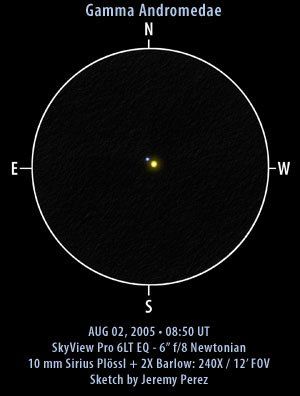Double Star of the Month:
Gamma Andromedae
AKA: Almach; STF 205. Position: 02 hr 03.9 min 42 degrees 19 min 48 sec
Due south at 22:24 (GMT) on 15 November 2020.
Image credit: Jeremy Perez (http://www.perezmedia.net/beltofvenus)
Used with permission
Gamma Andromedae was one of the first double stars to be recognised as such. Its duplicity was discovered by the German physicist Johann Tobias Mayer in 1777. William Herschel observed it on 25 August 1779, describing the colours as reddish white and fine light sky-blue, inclining to green. Most modern observers see it as yellow and blue in keeping with their stellar types K and B with colour contrast added. The magnitudes are 2.3 and 5, and the separation is a relatively narrow 9.4 arc seconds, but you should not have any trouble splitting it at a reasonably high magnification. It is a true binary system. The B component (also known as Gamma2) is itself double, but the separation of the 5.3 and 6.5 magnitude stars which was an already very tight 0.5 arc seconds when they were discovered in 1843 have now narrowed to an impossible 0.1 arc second. The official name of Gamma1 Andromedae is Almach, but it is often called Almaak. You can easily find Almach in a line-up of bright stars that begins with Alpheratz (Alpha Andromedae) in the Square of Pegasus, through Delta Andromedae and Mirach (Beta Andromedae) to Almach and then on to Mirfak (Alpha Persei). In November 2020, Mars is directly below Mirach.
